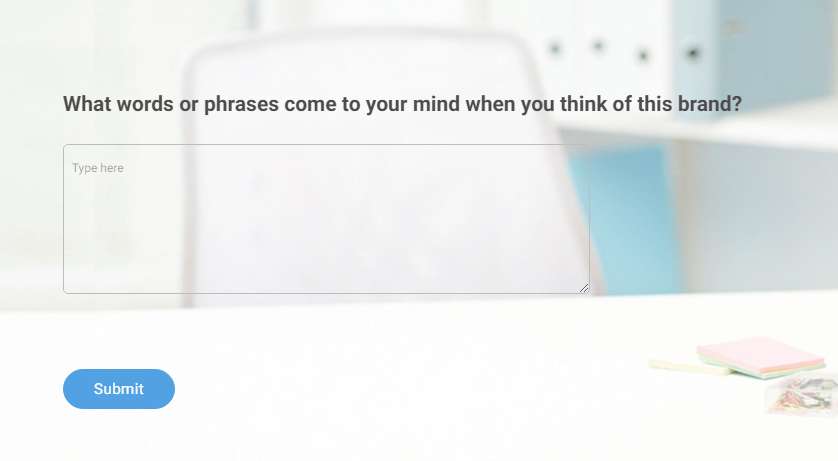
“Your brand is what other people say about you when you are not in the room.” – Jeff Bezos, Founder, Amazon
Brand perception survey questions are the key to understanding how your audience truly views your brand. Whether you’re a startup or an established player, how customers perceive your brand shapes everything from brand loyalty to profitability.
They reveal how customers emotionally connect with your brand—do they trust you, recognize your value, and remain loyal to your products or services?
In this blog, we’ll explore brand perception survey questions, provide examples, explain why they matter, and offer tips for creating questions that yield actionable insights.
Let’s get started!
What Is a Brand Perception Survey?
Watch: How to Create Engaging Surveys Online with ProProfs Survey Maker – Free & Easy
A Brand Perception Survey is a tool used to measure how customers and the general public perceive a brand. It focuses on gathering insights into the emotions, associations, and overall impressions that your brand evokes in the minds of your target audience.
But to truly know your respondents’ thoughts, you must create engaging surveys with a high response rate. Watch this quick tutorial to learn how:

Create a Brand Perception Survey Now
Questions in these surveys usually revolve around your target audience’s awareness, familiarity, and opinions of your brand’s products, services, and reputation.
The survey covers various aspects, such as:
- Brand Recognition: How well do people recognize your brand among competitors?
- Emotional Connection: What feelings does your brand evoke? Trust? Excitement? Neutrality?
- Brand Associations: What words or attributes do people associate with your brand?
- Customer Loyalty: How likely are they to recommend your brand to others?
The insights from a brand perception survey help businesses identify areas for improvement, refine their messaging, and align their branding with customer expectations.
15 Brand Perception Survey Questions for Customers
Here’s a comprehensive and meaningful Brand Perception Survey designed to gather well-rounded, nuanced data from customers. The questions include a variety of question types—open-ended, Likert scale, multiple choice, and rating scale—allowing for deep insights into your brand’s perception.
1. How familiar are you with our brand?
(Multiple Choice)
- Very familiar
- Somewhat familiar
- Heard of it but don’t know much
- Not familiar at all
2. How would you describe your overall perception of our brand?
(Open-Ended)
- ___________________________________________________________________

3. What words come to mind when you think of our brand?
(Multiple Choice – Select up to 3)
- Trustworthy
- Innovative
- Affordable
- High-quality
- Friendly
- Other [____________________________]
4. How likely are you to recommend our brand to a friend or colleague?
(Rating Scale: 0-10)
| 0 | 1 | 2 | 3 | 4 | 5 | 6 | 7 | 8 | 9 | 10 |
0 (Not Likely) – 10 (Extremely Likely)

5. How would you rate the quality of our products/services?
(Rating Scale: 1-5 stars)
- 1 star (Poor)
- 2 stars (Below Average)
- 3 stars (Average)
- 4 stars (Good)
- 5 stars (Excellent)
6. How would you compare our brand to competitors?
(Likert Scale)
- Much worse
- Somewhat worse
- About the same
- Somewhat better
- Much better

7. What do you think our brand does well?
(Open-Ended)
- [Text box for response]
8. What do you think our brand could improve on?
(Open-Ended)
- [Text box for response]
9. How emotionally connected do you feel to our brand?
(Likert Scale)
- Strongly connected
- Somewhat connected
- Neutral
- Somewhat disconnected
- Strongly disconnected
10. Which attributes best describe our brand’s customer service?
(Multiple Choice – Select all that apply)
- Responsive
- Helpful
- Friendly
- Professional
- Difficult to reach
- Unhelpful
- Other [Text box for response]
11. How often do you interact with our brand (purchase, engage, use our services)?
(Multiple Choice)
- Weekly
- Monthly
- A few times a year
- Rarely
- Never
12. How consistent is our branding across different channels (e.g., website, social media, in-store)?
(Likert Scale)
- Very consistent
- Somewhat consistent
- Neutral
- Somewhat inconsistent
- Very inconsistent
13. Do you feel that our brand understands your needs as a customer?
(Yes/No Question)
- Yes
- No

14. How likely are you to continue purchasing from our brand in the future?
(Rating Scale: 1-10)
| 0 | 1 | 2 | 3 | 4 | 5 | 6 | 7 | 8 | 9 | 10 |
1 (Not Likely) – 10 (Extremely Likely)
15. Please rate the value for money our products/services offer.
(Rating Scale: 1-5 stars)
- 1 star (Very Poor)
- 2 stars (Poor)
- 3 stars (Average)
- 4 stars (Good)
- 5 stars (Excellent)

What Does a Brand Perception Survey Do
A brand perception survey serves as a tool for understanding how your target audience views your brand. It provides insights into the emotional and cognitive associations people have with your brand and helps identify what drives their perceptions, whether positive or negative.
Here’s what a brand perception survey does:
- Measures Brand Awareness: It gauges how familiar your audience is with your brand and how often they think about or recognize it compared to competitors.
- Assesses Emotional Impact: It uncovers the emotions or feelings that your brand evokes in consumers, which is critical for understanding customer loyalty and engagement.
- Evaluates Brand Associations: The survey pinpoints the specific attributes or characteristics that people associate with your brand, whether it’s trustworthiness, innovation, quality, or something else.
- Identifies Strengths and Weaknesses: By asking direct questions about how people perceive your products, services, and overall brand identity, the survey helps highlight areas of strength and opportunities for improvement.
- Helps Make Informed Strategies: The insights gathered inform marketing, branding, and customer experience strategies, allowing businesses to adjust their messaging, improve customer relations, and enhance overall brand positioning.
Why Are Brand Perception Surveys Important?
Brand perception is everything. It’s the intangible asset that can make or break a business.
Brand perception surveys are the microscope through which you examine how your customers, potential customers, and even employees view your brand.
By understanding these perceptions, you gain invaluable insights into:
- Customer satisfaction and loyalty: Identifying areas of strength and weakness can directly impact customer retention and advocacy.
- Market positioning: Understanding how your brand stacks up against competitors helps refine your unique selling proposition.
- Brand messaging effectiveness: Measuring how well your brand story resonates with your target audience.
- Identifying opportunities: Uncovering unmet customer needs can lead to innovative product or service development.
- Crisis management: Early detection of negative sentiment can help mitigate potential damage.
But beyond the obvious, brand perception surveys are the secret weapon for businesses seeking a competitive edge.
By uncovering the underlying reasons behind brand perceptions, businesses can identify hidden opportunities, refine their value proposition, and anticipate market shifts. For instance, a survey might reveal a disconnect between a brand’s perceived values and actions, allowing for strategic alignment.
Moreover, by benchmarking against competitors, businesses can pinpoint areas where they excel and where they need to improve.
FREE. All Features. FOREVER!
Try our Forever FREE account with all premium features!
Brand Perception Survey Tips & Best Practices for Quality Insights
When conducting a brand perception survey, the goal is to extract high-quality insights that can guide your branding strategy. To do this effectively, you need more than just well-crafted questions—you need a strategic approach.
Let’s break this down into two distinctive parts. First, we’ll explore some of the best practices in detail and then discuss the tips.
Best Practices to Improve Brand Perception:
If you don’t have a stellar brand perception already, let’s look at what can help you build it.
1. Identify Your Target Audience & Their Preferences
Understanding your right brand audience is the first step in aligning your brand perception in the right direction. Who are your regular customers? What are their demographics? And what are their choices? These answers can be found by closely analyzing your website visitors or email lists that capture the demographics of your customers. Also, keep track of previous customers and see if they can be converted back to customers.
Collect these demographic details of your audience:
- Location
- Age
- Gender
- Race
- Religion
- Marital status
- Household Income
Know your audience’s choices with surveys focusing on:
- Do they purchase retail or wholesale products?
- How frequently do they purchase?
- What are their hobbies?
- What values do they adhere to?
2. Understand Audience Perception of Prices
Different audiences have different perceptions of brand pricing. Some of them believe in paying high prices in return for high-quality products, while others believe in cost-effective products irrespective of quality. Few others seek both quality and low prices.
You need to find out in which of these categories most of your audiences fall and serve them better. In this way, you can balance the aspirations of different audience types and enhance your brand perception.
Different pricing strategies that are followed by brands to target their audiences are –
- Price Skimming: It is adopted when a business introduces a new product or service. This involves selling the products at high prices. Eventually, the prices are lowered to match with the competitor brands.
- Bundle Pricing: The process of offering a combination of products at lower prices is known as bundle pricing. Individually, the products would have a high cost. This is a psychological way to lure your customers into buying your products.
- Economy Pricing: It is generally adopted by retail or food supplier brands. Here, you offer very low prices to your most price-conscious customers. This is a cost-effective way to reach out to your customers without additional marketing costs.
However, to be up to date on the current pricing trends, you should first get a clear picture of what other offers are out there. It is advisable to use various data collection tools that could provide you with all the necessary pricing information in your niche.
3. Build Positive Relationships with Your Customers
Customers are more likely to purchase from brands with which they have a good relationship. Developing a positive interaction trend with your audience is paramount to building a great brand perception and customer loyalty.
To improve your goodwill with people:
- Offer the best, most efficient customer support service possible to your clients at all stages of your interaction. Positive brand perception grows on positive experiences, and outstanding support is one of the finest avenues of providing one.
- Find ways to connect with your customers on a personal level. Send birthday emails, and personalized gifts on special occasions, and open up channels of discussing what your customers truly care about in your campaigns.
- Actively engage with your audience regularly. Build a reliable presence on social media, invest in a strong email marketing regime, and update your blogs to keep yourself in vogue.
- Be humble. Listen and respond to feedback to upgrade your products to the current market expectations and possibly, even better!
4. Understand Drivers and Barriers
What products or services appeal most to your target audience? A thorough understanding of your drivers helps you identify your best-performing products and project them effectively. For example, customers might love your product quality or the free home delivery feature. You can easily project these qualities as your Unique Selling Proposition (USP) on social media.
On the flip side, there could also be some barriers that customers face, like slow loading of websites, less range of products compared to competitors, and so on. You can understand these barriers through regular brand perception surveys.
5. Look for Unexplored Opportunities
“Business opportunities are like buses; there is always another one coming,”
– Richard Branson, founder of Virgin Group
The business field is buzzing with new ideas and innovations. There is always a hidden opportunity that your business can grab. Even if you find it challenging initially, you can always do market research, learn from your competitors, and work hard to the top.
A great way to get started with looking for unexplored opportunities or getting a better understanding of brand perception for your company is by hiring a PR team. While this may be a little expensive or outside your budget initially, it can make quite a difference.
If you aren’t ready to hire a full-time PR team, you can always get started using PR outreach software. This can give you a great introduction to PR’s benefits and may more than meet your current needs. You can always upgrade later should you choose to go in for a full-time PR team
5. Build Brand Equity
Brand equity defines the social value of your brand: How well does your brand connect to the customer’s feelings and emotions? As opposed to the financial value which depends on the quantity of your product, the social value depends on the quality of your product. Quality, in turn, comes with innovative product features, ease of usability, durability, and more.
Brand equity can be built with these basic steps:
- Create brand awareness through in-depth blogs, video tutorials, podcasts, referral programs, enhancing SEO, and so on. Once your audience identifies with your brand values, they will be more likely to engage with your organization.
- Communicate with your target audience about your brand values, mission, goals, product features, etc. For this, you can use attractive visual imagery and videos on your website.
- Build a close bond with your customers by bringing special customer loyalty programs, focus groups, and discussion forums. It brings in a sense of community and belonging, leading to repeated purchases from your brand.
Now that we are done with strategies, let’s look at some tips.
Tips to Improve Brand Perception
1. Target Your Audience Precisely
- Segment meticulously: Divide your audience into granular segments based on demographics, psychographics, purchase behavior, and loyalty levels. This ensures tailored questions and actionable insights.
- Prioritize primary audience: Focus on the segment that contributes most to your revenue or is crucial for future growth.
- Leverage existing data: Combine survey data with CRM and purchase history to create highly targeted respondent lists.
2. Design Thought-Provoking Questions
- Avoid leading questions: Frame questions neutrally to prevent biased responses.
- Mix question types: Employ a combination of Likert scale, multiple choice, open-ended, and rating scale questions to capture diverse perspectives.
- Prioritize open-ended questions: While challenging to analyze, these provide qualitative depth and uncover unanticipated insights.
- Use vivid language: Paint a picture with your questions to evoke emotional responses and detailed answers. For instance, instead of “How do you feel about our brand?”, ask “What emotions does our brand evoke in you?”
3. Maximize Response Rates
- Keep it concise: Aim for a survey length of 5-7 minutes to maintain respondent engagement.
- Offer incentives: Consider rewards or exclusive offers for completing the survey.
- Personalize invitations: Tailor the survey invitation to the recipient, increasing relevance and interest.
- Multiple touchpoints: Send reminders and follow-ups to boost response rates.
4. Analyze and Act
- Qualitative and quantitative analysis: Combine numerical data with textual insights for a holistic view.
- Benchmark against competitors: Identify areas of strength and weakness relative to the market.
- Prioritize findings: Focus on insights with the highest impact potential.
- Create a closed-loop system: Implement changes based on survey findings and measure their effectiveness.
By following these guidelines, you’ll transform your brand perception survey from a mere exercise into a strategic tool driving business growth.
Redefine Your Image with Brand Perception Surveys!
From automotive to software industries, brand perception has transformed over the years. Customers are no longer just seeking low prices; they’re willing to pay more for quality products and services that align with strong branding and excellent customer support.
These factors combine to create a positive brand perception that fuels loyalty and growth.
Measuring brand perception can take many forms, from tracking website traffic to analyzing online reviews, but nothing is as direct and insightful as conducting a brand perception survey.
With ProProfs Survey Maker, you can easily craft engaging, targeted surveys that provide the insights you need to refine your brand strategy. The tool offers features like 20+ Question Types, 100+ customizable templates, powerful analytics, and real-time feedback collection, helping you tap into unexplored opportunities for greater growth.
Ready to understand your audience and improve your brand perception? Start creating your survey today!
Learn More About Brand Perception Surveys
Who should you ask brand survey questions?
Ideally, you should survey a mix of current customers, potential customers, and even former customers. Current customers provide insights into satisfaction, while potential customers reveal your brand’s perception in the market. Former customers can offer valuable feedback on why they left.
Who should you send your brand perception survey to?
Your target audience should be the primary focus. Beyond that, consider employees, partners, and influencers. Employee feedback reflects internal brand perception, while partners and influencers offer external perspectives.
How do you write a brand perception survey?
- Define your goals: Clearly outline what you aim to achieve with the survey.
- Identify key metrics: Determine which aspects of your brand you want to measure (awareness, image, loyalty, etc.).
- Create a mix of questions: Use a combination of open-ended and closed-ended questions to gather both quantitative and qualitative data.
- Keep it concise: Aim for a survey length of 5-7 minutes to maintain respondent engagement.
- Pilot test: Send the survey to a small group to identify any issues before full deployment.
FREE. All Features. FOREVER!
Try our Forever FREE account with all premium features!

 We'd love your feedback!
We'd love your feedback!
 Thanks for your feedback!
Thanks for your feedback!






